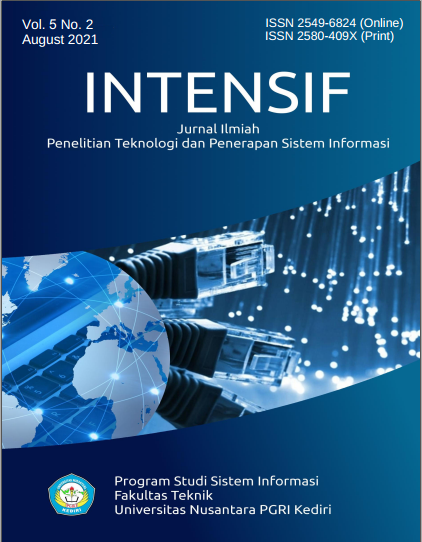Design of Checkers Game Using Alpha-Beta Pruning Algorithm
DOI:
https://doi.org/10.29407/intensif.v5i2.15863Keywords:
Checkers, Artificial Intelligence, Alpha Beta PruningAbstract
Checkers is a board game that is played by two people which has a purpose to defeat the opponent by eating all the opponent's pieces or making the opponent unable to make a move. The sophistication of technology at this modern time makes the checkers game can be used on a computer even with a smartphone. The application of artificial intelligence in checkers games makes the game playable anywhere and anytime. Alpha Beta Pruning is an optimization technique from the Minimax Algorithm that can reduce the number of branch/node extensions to get better and faster step search results. In this study, a checkers game based on artificial intelligence will be developed using the alpha-beta pruning method. This research is expected to explain in detail how artificial intelligence works in a game. Alpha-beta pruning was chosen because it can search for the best steps quickly and precisely. This study tested 10 respondents to play this game. The results show that the player's win rate was 60% at the easy level, 40% at the medium level, and 20% at the hard level. Besides that, the level of interest in this game was 80% being entertained and 20% feeling ordinary.
Downloads
References
F. Marzian dan M. Qamal, “Game Rpg ‘The Royal Sword’ Berbasis Desktop Dengan Menggunakan Metode Finite State Machine (Fsm),” J. Ilm. Sist. Inf. SISFO, vol. 1, no. 2, hlm. 36, 2017.
I. P. W. Merta, I. M. G. Sunarya, dan I. K. R. Arthana, “Handgesture To Text Dengan Metode Artificial Intelligence KNN (K-Nearest Neighbour),” Kumpul. Artik. Mhs. Pendidik. Tek. Inform., vol. 4, no. 1, hlm. 10, 2015.
D. A. Hashimoto, T. M. Ward, dan O. R. Meireles, “The Role of Artificial Intelligence in Surgery,” Adv. Surg., vol. 54, hlm. 89–101, Sep 2020, doi: 10.1016/j.yasu.2020.05.010.
C. Waruwu dan D. Purba, “Implementasi Algoritma Minimax Dalam Game Othello,” J. Tek. Inform. Unika St Thomas JTIUST, vol. 2, no. 1, hlm. 11, 2017.
M. F. Rahadian, A. Suyatno, dan S. Maharani, “Penerapan Metode Finite State Machine Pada Game ‘The Relationship,’” Jurnal Informatika Mulawarman, vol. 11, hlm. 9, 2016.
Y. Duan, J. S. Edwards, dan Y. K. Dwivedi, “Artificial Intelligence For Decision Making In The Era Of Big Data – Evolution, Challenges And Research Agenda,” Int. J. Inf. Manag., vol. 48, hlm. 63–71, Okt 2019, doi: 10.1016/j.ijinfomgt.2019.01.021.
M. Kurniawan, A. Pamungkas, dan S. Hadi, “Algoritma Minimax Sebagai Pengambil Keputusan Dalam Game Tic-Tac-Toe,” Open Journal System SEMNASTEKNOMEDIA ONLINE, vol. 4, hlm. 6, 2016.
D. Syapnika dan E. R. Siagian, “Penerapan Algoritma Minimax Pada Permainan Checkers,” J. Ris. Komput. JURIKOM, vol. 2, no. 6, hlm. 28–32, 2015.
G. Acampora, V. Loia, dan A. Vitiello, “Improving game bot behaviours through timed emotional intelligence,” Knowl.-Based Syst., vol. 34, hlm. 97–113, Okt 2012, doi: 10.1016/j.knosys.2012.04.012.
B. Billy, I. Kuswardayan, dan W. N. Khotimah, “Implementasi Artificial Intelligence pada game Defender of Metal City dengan menggunakan Finite State Machine,” J. Tek. ITS, vol. 6, no. 2, hlm. A701-706, Okt 2017, doi: 10.12962/j23373539.v6i2.25151.
M. H. Kurniawan dan D. Udjulawa, “Perbandingan Performa Algoritma Minimax Dan Alpha- Beta Pruning Pada Game Catur Cina,” J. Algoritme, vol. 1, no. 1, hlm. 9, 2020.
N. Azis, R. Puspasari, dan W. Verina, “Perancangan Aplikasi Chess Game Dengan Algoritma Alpha Beta Pruning,” J. FTIK, vol. 1, no. 1, hlm. 325–331, 2020.
N. P. Sijabat, M. A. Riad, J. S. Muda, dan D. B. Sanjaya, “Analisa Efektivitas Algoritma Minimax, Alpha Beta Pruning, dan Negamax dalam Penerapannya pada Permainan Papan (Board Game),” J. Ilmu Komput. Dan Sist. Inf. JIKOMSI, vol. 3, no. 2, hlm. 11, 2020.
M. R. Handoko dan F. Indriani, “Perbandingan Algoritma Minimax Dengan Alphabeta Pruning Pada Permainan Mul- Mulan,” Semin. Nas. Ilmu Komput. SOLITER, vol. 2, hlm. 7, 2019.
J. N, V. K. B. C, M. S. Nadiger, N. R, dan S. H. N, “Alpha-Beta Pruning-A Streamline Approach For Perceptive Game Playing,” Int. Res. J. Mod. Eng. Technol. Sci., vol. 2, no. 6, hlm. 1306–1318, Jun 2020.
D. S. Purnia, A. Rifai, dan S. Rahmatullah, “Penerapan Metode Waterfall dalam Perancangan Sistem Informasi Aplikasi Bantuan Sosial Berbasis Android,” Semin. Nas. Sains Dan Teknol. Pros., hlm. 7, 2019.
O. Alfina, “Sistem Informasi Mobile Assistant Mahasiswa Jurusan Sistem Informasi Fakultas Komputer Universitas Potensi Utama Berbasis Android,” JITEKH, vol. 7, no. 01, hlm. 1–6, Mei 2019, doi: 10.35447/jitekh.v7i01.3.
A. K. Effendi, R. Delima, dan A. R. Chrismanto, “Implementasi Algoritma Negascout Untuk Permainan Checkers,” J. Inform., vol. 8, no. 1, Jul 2012, doi: 10.21460/inf.2012.81.112.
A. Taqwiym, “Pendekatan Algoritma Greedy Untuk Menentukan Langkah Bidak Pada Permainan Checkers,” Kurawal - J. Teknol. Inf. Dan Ind., vol. 1, no. 2, hlm. 89–97, Okt 2018, doi: 10.33479/kurawal.2018.1.2.89-97.
E. R. Escandon dan J. Campion, “Minimax Checkers Playing GUI: A Foundation for AI Applications,” dalam 2018 IEEE XXV International Conference on Electronics, Electrical Engineering and Computing (INTERCON), Lima, Agu 2018, hlm. 1–4, doi: 10.1109/INTERCON.2018.8526375.
Downloads
Published
Issue
Section
License
Authors who publish with this journal agree to the following terms:
- Copyright on any article is retained by the author(s).
- The author grants the journal, the right of first publication with the work simultaneously licensed under a Creative Commons Attribution License that allows others to share the work with an acknowledgment of the work’s authorship and initial publication in this journal.
- Authors are able to enter into separate, additional contractual arrangements for the non-exclusive distribution of the journal’s published version of the work (e.g., post it to an institutional repository or publish it in a book), with an acknowledgment of its initial publication in this journal.
- Authors are permitted and encouraged to post their work online (e.g., in institutional repositories or on their website) prior to and during the submission process, as it can lead to productive exchanges, as well as earlier and greater citation of published work.
- The article and any associated published material is distributed under the Creative Commons Attribution-ShareAlike 4.0 International License












